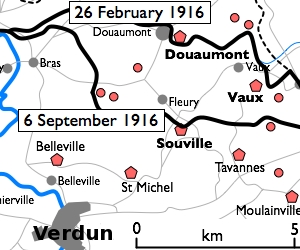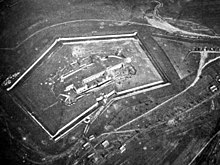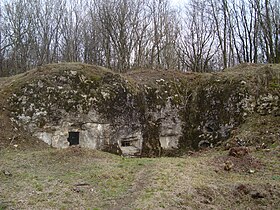
The Battle of Verdun was fought from 21 February to 18 December 1916 on the Western Front in France. The battle was the longest of the First World War and took place on the hills north of Verdun-sur-Meuse. The German 5th Army attacked the defences of the Fortified Region of Verdun and those of the French Second Army on the right (east) bank of the Meuse. Using the experience of the Second Battle of Champagne in 1915, the Germans planned to capture the Meuse Heights, an excellent defensive position, with good observation for artillery-fire on Verdun. The Germans hoped that the French would commit their strategic reserve to recapture the position and suffer catastrophic losses at little cost to the German infantry.
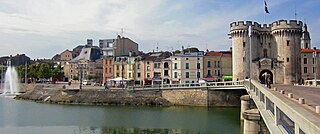
Verdun is a city in the Meuse department in Grand Est, northeastern France. It is an arrondissement of the department.

The Siege of Maubeuge took place from 24 August – 7 September 1914, at the Entrenched Camp of Maubeuge the start of the First World War on the Western Front. The railway from Thionville to Luxembourg City, Arlon and Namur into Belgium had been cut by the demolition of the rail bridge over the Meuse at Namur in Belgium. During the siege, the German armies in the north could use only the single-track line from Trier to Liège, Brussels, Valenciennes and Cambrai, which could accommodate a maximum of forty trains a day.
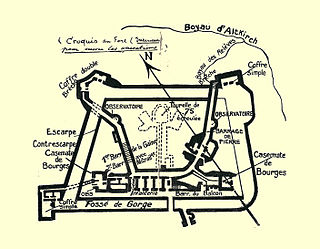
Fort Vaux, in Vaux-Devant-Damloup, Meuse, France, was a polygonal fort forming part of the ring of 19 large defensive works intended to protect the city of Verdun. Built from 1881 to 1884 for 1,500,000 francs, it housed a garrison of 150 men. Vaux was the second fort to fall in the Battle of Verdun after Fort Douaumont, which was captured by a small German raiding party in February 1916 in the confusion of the French retreat from the Woëvre plain. Vaux had been modernised before 1914 with reinforced concrete top protection like Fort Douaumont and was not destroyed by German heavy artillery fire, which had included shelling by 16-inch (410 mm) howitzers. The superstructure of the fort was badly damaged but the garrison, the deep interior corridors and stations were intact when the fort was attacked on 2 June by German Stormtroops.
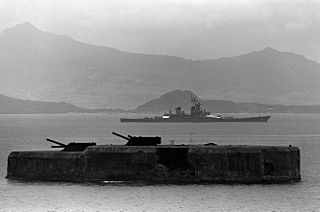
Fort Drum, also known as El Fraile Island, is a heavily fortified island situated at the mouth of Manila Bay in the Philippines, due south of Corregidor Island. Nicknamed a "concrete battleship", the reinforced concrete sea fort, shaped like a battleship, was built by the United States in 1909 as one of the harbor defenses at the wider South Channel entrance to the Bay during the American colonial period.

The Séré de Rivières system was an ensemble of fortifications built from 1874 along the frontiers, ridges and coasts of France. The fortifications were named after their architect, Brigadier-General Raymond Adolphe Séré de Rivières. The fortresses were obsolescent by 1914 but were used during the First World War.

The Battle of Fort Ében-Émael was a battle between Belgian and German forces that took place between 10 May and 11 May 1940, and was part of the Battle of Belgium and Fall Gelb, the German invasion of the Low Countries and France. An assault force of German paratroopers, Fallschirmjäger, was tasked with assaulting and capturing Fort Ében-Émael, a Belgian fortress whose strategic position and strong artillery emplacements dominated several important bridges over the Albert Canal. These carried roads which led into the Belgian heartland and were what the German forces intended to use to advance. As some of the German airborne forces assaulted the fortress and disabled the garrison and the artillery pieces inside it, others simultaneously captured three bridges over the canal. Having disabled the fortress, the airborne troops were then ordered to protect the bridges against Belgian counter-attacks until they linked up with ground forces from the German 18th Army.

During World War I, France was one of the Triple Entente powers allied against the Central Powers. Although fighting occurred worldwide, the bulk of the French Army's operations occurred in Belgium, Luxembourg, France and Alsace-Lorraine along what came to be known as the Western Front, which consisted mainly of trench warfare. Specific operational, tactical, and strategic decisions by the high command on both sides of the conflict led to shifts in organizational capacity, as the French Army tried to respond to day-to-day fighting and long-term strategic and operational agendas. In particular, many problems caused the French high command to re-evaluate standard procedures, revise its command structures, re-equip the army, and to develop different tactical approaches

The Fort de Liouville, also known as Fort Stengel, located between the communes of Saint-Agnant-sous-les-Côtes and Saint-Julien-sous-les-Côtes, near the town of Commercy in the Meuse departement of France, is one of the forts built at the end of the 19th century to defend the valley of the Meuse. The fort was located on what was then the French frontier facing the German-occupied province of Lorraine. The Fort de Liouville was located between the Fort de Gironville and the Camp des Romains.

Ouvrage La Ferté, also known as Ouvrage Villy-La Ferté, is a petit ouvrage of the Maginot Line, located in the Fortified Sector of Montmédy, facing Belgium. The ouvrage lies between the towns of Villy and La Ferté-sur-Chiers. It possesses two combat blocks linked by an underground gallery. The westernmost position in its sector, it was a comparatively weakly armed fortification in an exposed position that left it vulnerable to isolation and attack. After a sustained attack during the Battle of France, the position was overwhelmed by German forces and was destroyed with its entire garrison killed. The fighting at La Ferté was the heaviest of any position in the Maginot Line. It is preserved as a war memorial.

The Fortified Sector of Montmédy was the French military organisation that in 1940 controlled the section of the Maginot Line between Sedan and Longuyon, a distance of about 60 kilometres (37 mi). The sector was not as strongly defended as other sections of the Maginot Line, facing the southern Ardennes region of Belgium. Large portions of the Montmédy sector were defended by fortified houses, blockhouses or casemates. The sector includes only four ouvrages of the type found in stronger sections of the Line. The weakly defended area in front of Sedan was the scene of a major breakthrough by German forces in the opening of the Battle of France. This was followed by a German assault on the Maginot Ouvrage La Ferté, which killed the entire garrison, the only such event on the Maginot Line.

The Fort de Barchon is one of twelve forts built around Liège, Belgium, in the late 19th century. The overall Fortified Position of Liège was a constituent part of the country's National Redoubt. Fort de Barchon was built between 1881 and 1884 according to the plans of General Henri Alexis Brialmont. Contrasting with the French forts built in the same era by Raymond Adolphe Séré de Rivières, the fort was built exclusively of unreinforced concrete, a new material, rather than masonry. The fort was heavily bombarded by German artillery in the Battle of Liège. Barchon was upgraded in the 1930s in an attempt to forestall or slow an attack from Germany. It saw action in 1940 during the Battle of Belgium, and was captured by German forces. It is preserved as a museum and may be visited by the public.

The Fortified Sector of Rohrbach was the French military organization that in 1940 controlled the section of the Maginot Line in the vicinity of Bitche. The sector was bordered to the west by the Fortified Sector of the Sarre and to the east by the Fortified Sector of the Vosges. With lower priority than other sectors, the SF Rohrbach was built somewhat later than its neighbors to the east and west, and in company with positions on the extreme western end of the Maginot Line, became one of the "New Fronts." The sector contains several major ouvrages and was the scene of fighting in both 1940 and 1944. It was attacked in 1940 by German forces in the Battle of France. The sector was heavily engaged by German forces in mid-June 1940, with several casemates and the petit ouvrage Welschhof surrendering before the Second Armistice at Compiègne. The remaining positions and their garrisons finally surrendered on 27 June 1940. In 1944 German forces occupied several positions in the SF Rohrbach, forcing advancing American forces to attack them individually or to bypass them. The German Operation Nordwind offensive of early 1945 caused American forces to fall back, returning to complete the capture of the Rohrbach sector in March 1945. Following the war many positions were reactivated for use during the Cold War. Two locations are now preserved and open to the public.

The Fort d'Andoy is one of nine forts built as part of the Fortifications of Namur in the late 19th century in Belgium. It was built between 1888 and 1892 according to the plans of General Henri Alexis Brialmont. Contrasting with the French forts built in the same era by Raymond Adolphe Séré de Rivières, the fort was built exclusively of unreinforced concrete, a new material, rather than masonry. In 1914 the fort was heavily bombarded by German artillery in the Battle of Namur. Andoy was upgraded in the 1930s to become part of the fortified position of Namur in an attempt to forestall or slow an attack from Germany. It saw action in 1940 during the Battle of Belgium, and was captured by German forces. The fort is now abandoned on private property.

The Obusier de 400 Modèle 1915/1916 were French railway howitzers that saw action during the First World War and World War II. The mle 1915/1916 was the largest caliber railway howitzers in service with the French Army during the First World War.
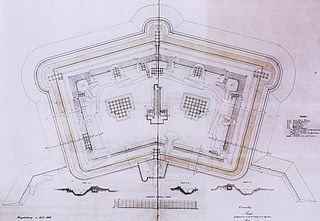
A polygonal fort is a type of fortification originating in France in the late 18th century and fully developed in Germany in the first half of the 19th century. Unlike earlier forts, polygonal forts had no bastions, which had proved to be vulnerable. As part of ring fortresses, polygonal forts were generally arranged in a ring around the place they were intended to protect, so that each fort could support its neighbours. The concept of the polygonal fort proved to be adaptable to improvements in the artillery which might be used against them, and they continued to be built and rebuilt well into the 20th century.

The 5.7 cm Maxim-Nordenfelt"Canon de caponnière" was a fortress gun and infantry gun developed during the 1880s in Britain which was sold to Belgium and later produced under license by the Cockerill company. It saw action during World War I in both Belgian and German hands.

Kurt Rackow was a German military officer and Pour le Mérite recipient who served in the Imperial German Army, Freikorps, and Reichswehr during World War I and the German Revolution of 1918–19. Rackow's most famous action was leading the capture of Fort Vaux during the Battle of Verdun.

Fort Souville, briefly called Fort Lemoine, was one of the forts of the Verdun Fortification District, situated in the commune of Fleury-devant-Douaumont. Constructed between 1876 and 1879 at an altitude of 396m, it is a first generation fort. It served as a key battlefield in the 1916 Battle of Verdun during World War I. The fort was armed on its ramparts with 9 cannons and 5 mortars, with 8 pieces of artillery used as flanking fire. A Bussiere turret in attached battery was also present.

Hans Karl von Guretzky-Cornitz (1855–1917) was a German army general of the First World War. He was commander of the 9th Reserve Division during the early part of the war. He is noted for an incident during the 1916 Battle of Verdun when he falsely reported capturing Fort Vaux and was awarded the Pour le Mérite.
